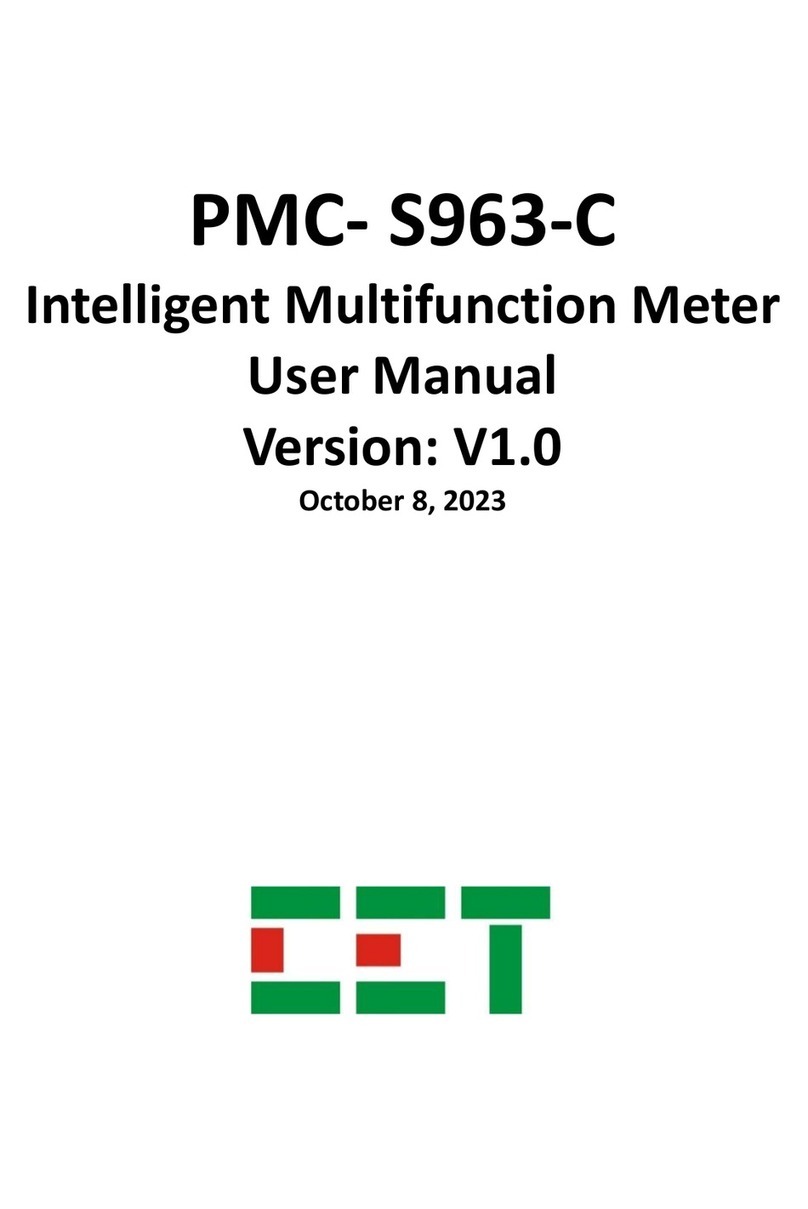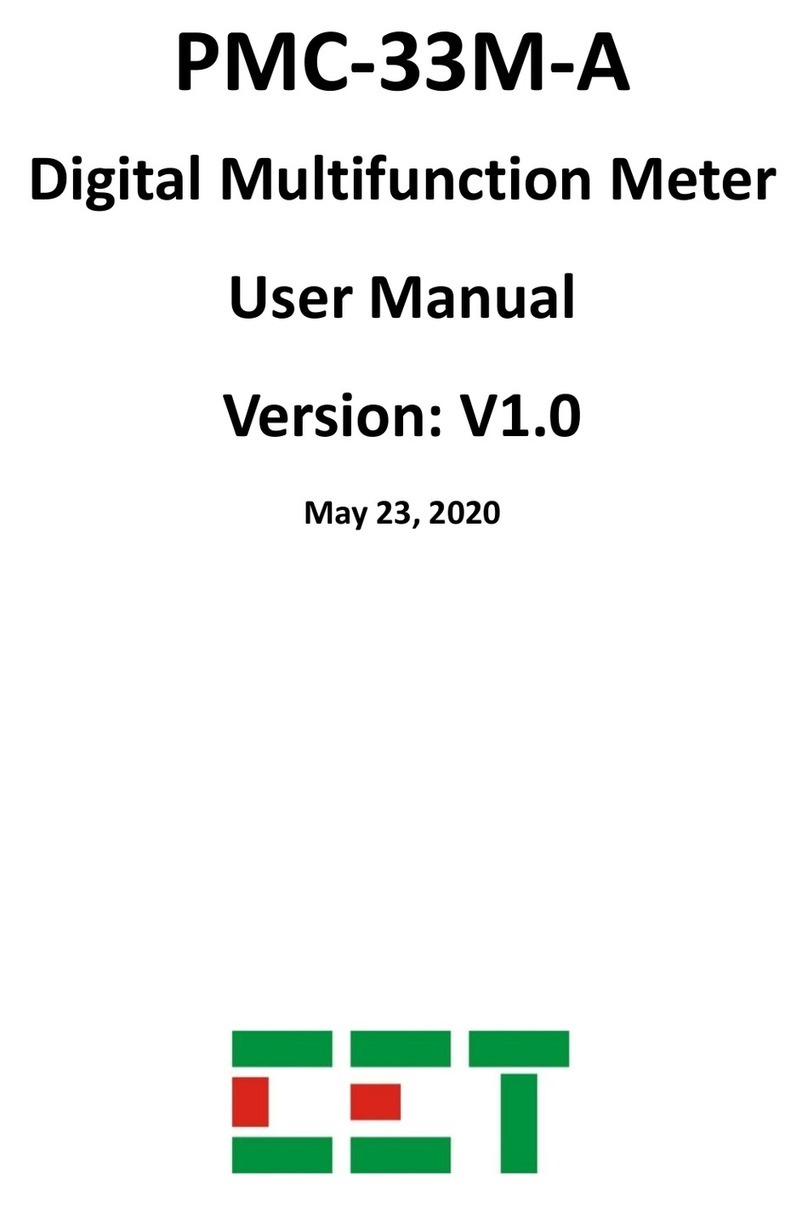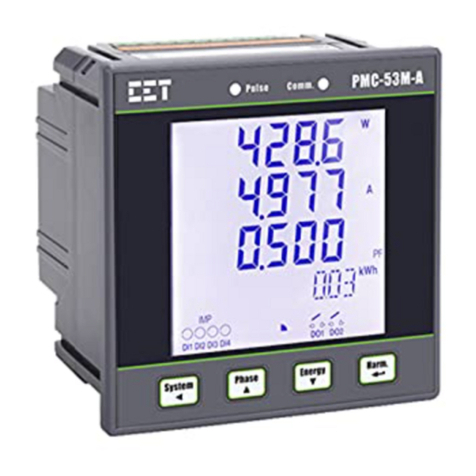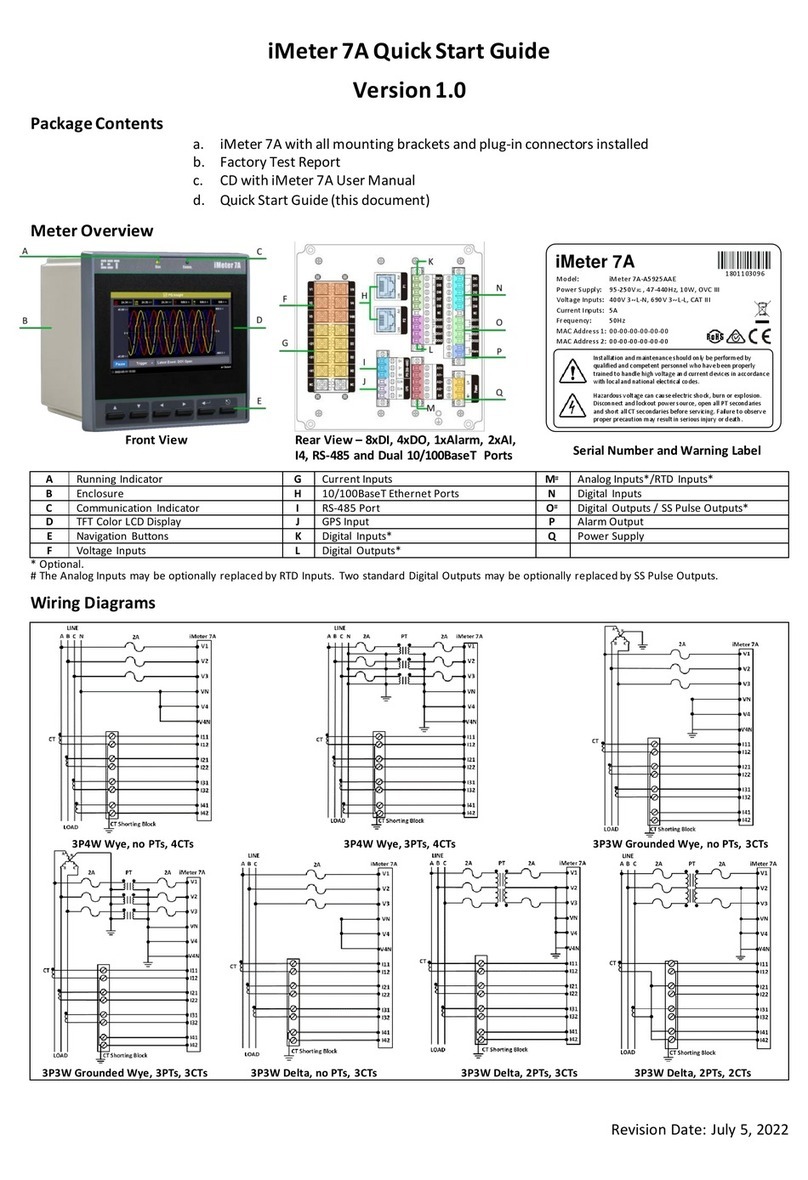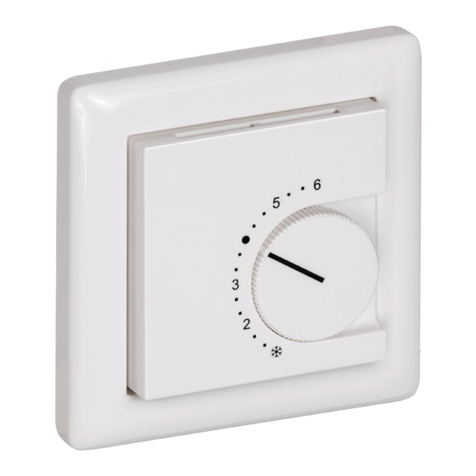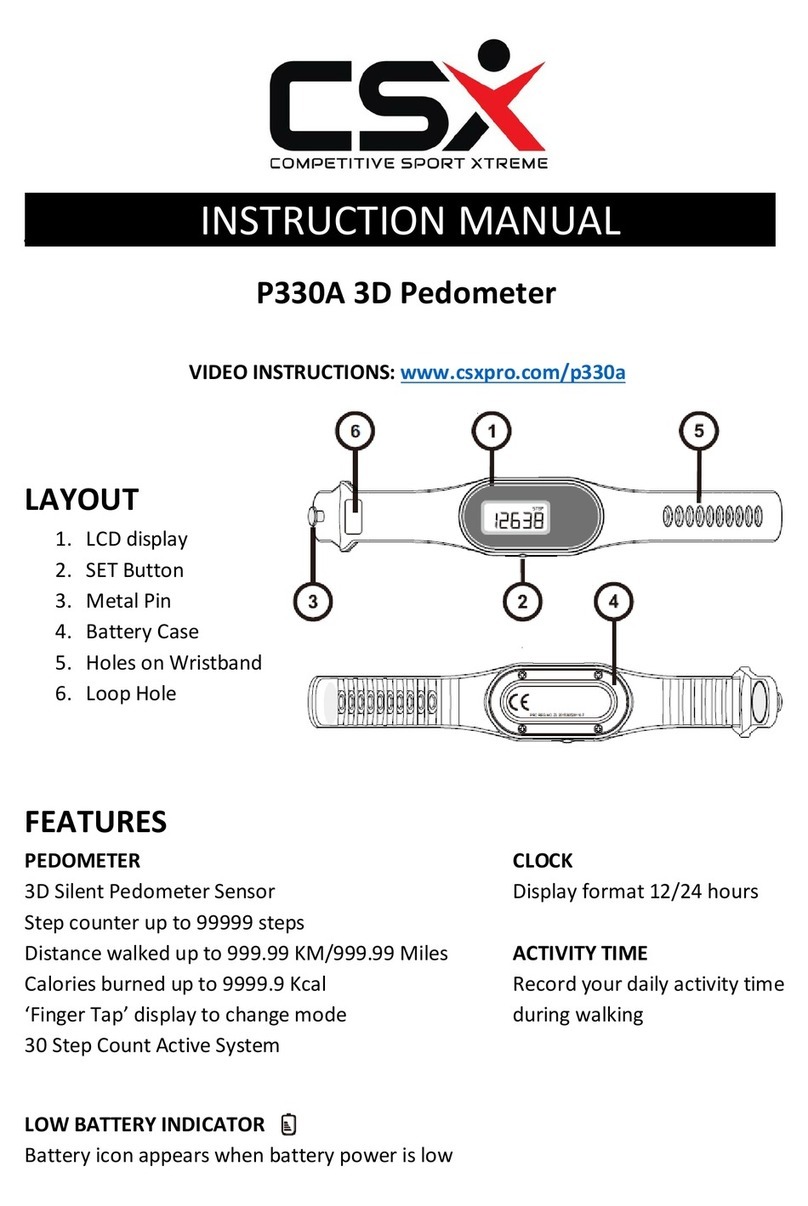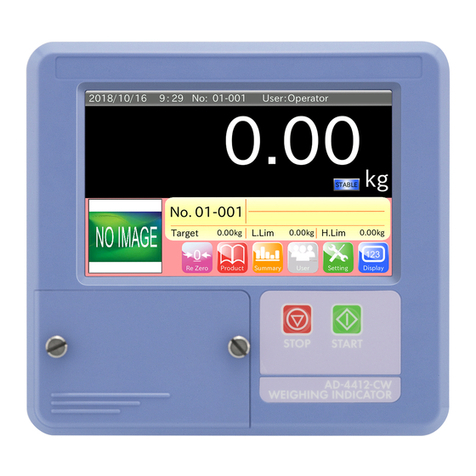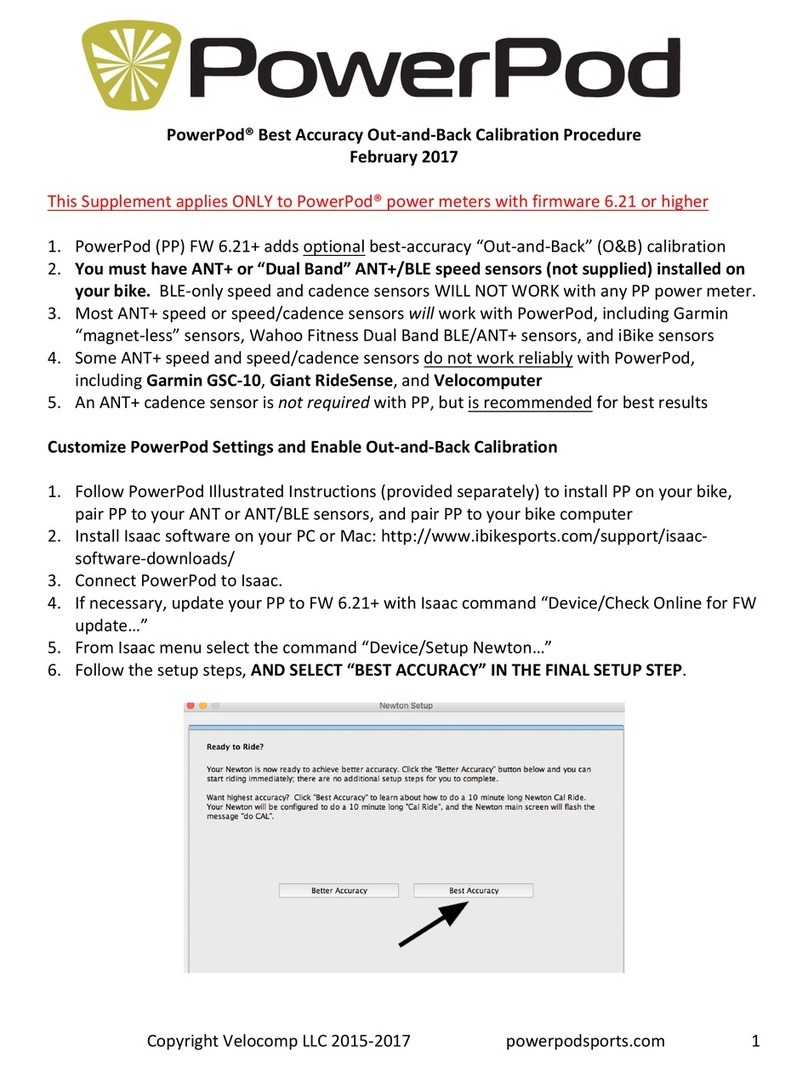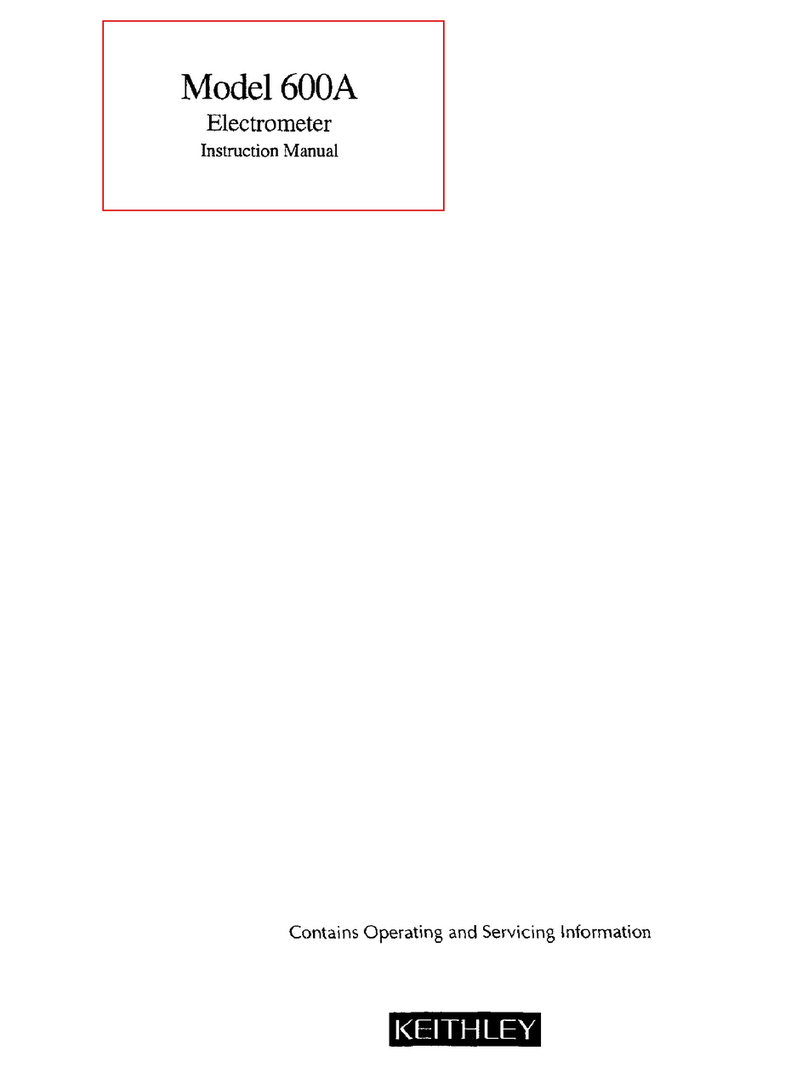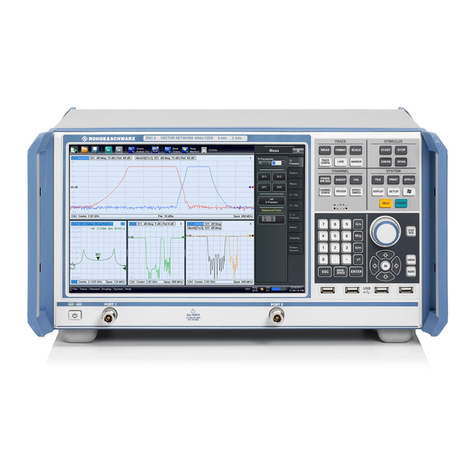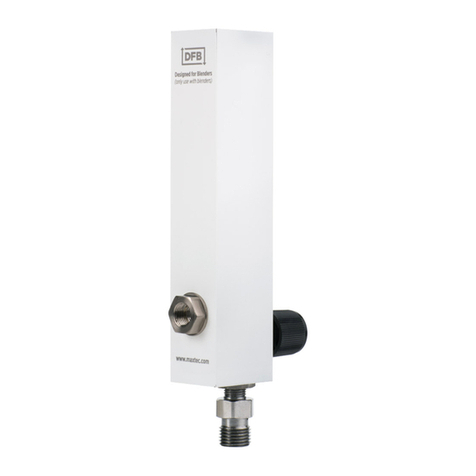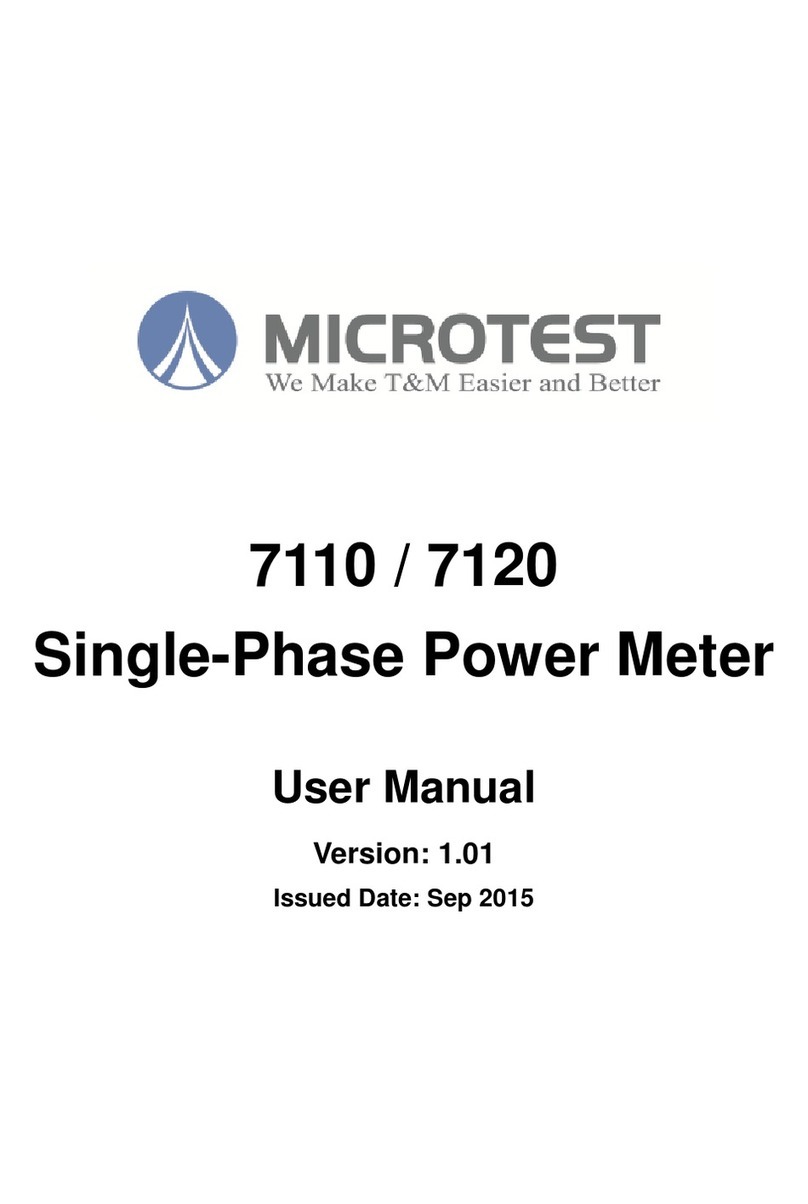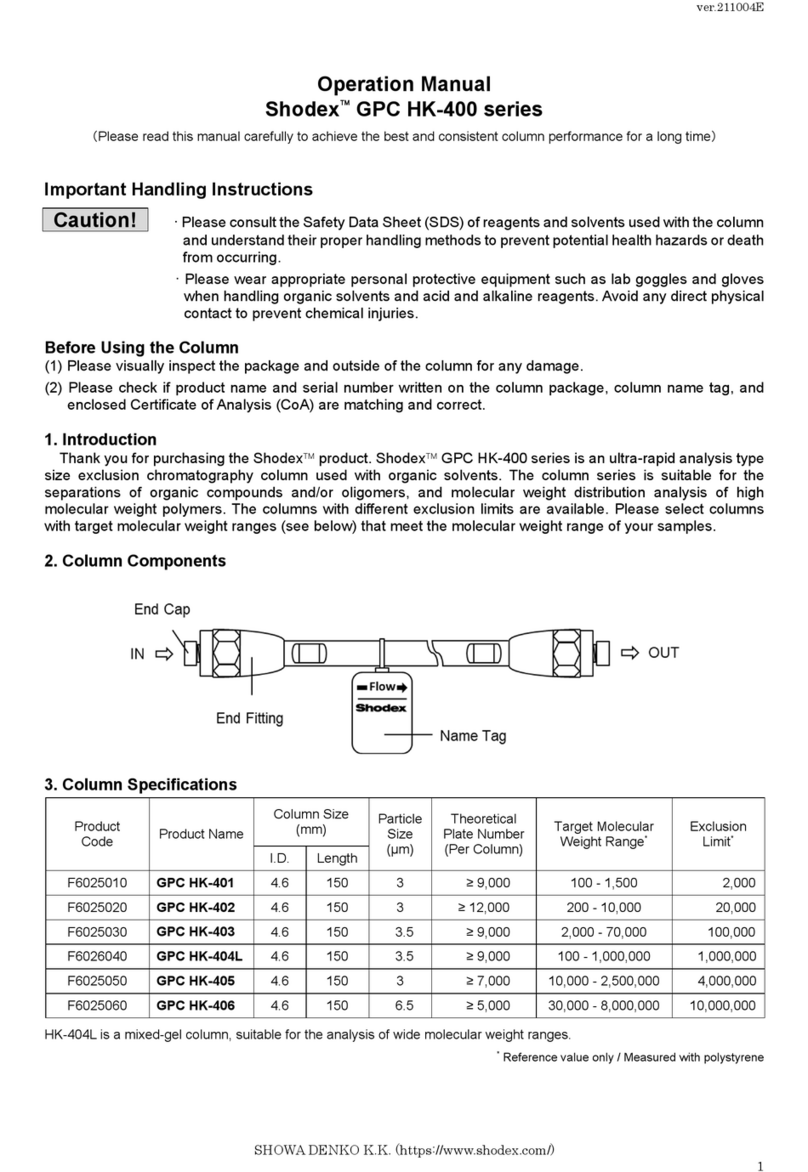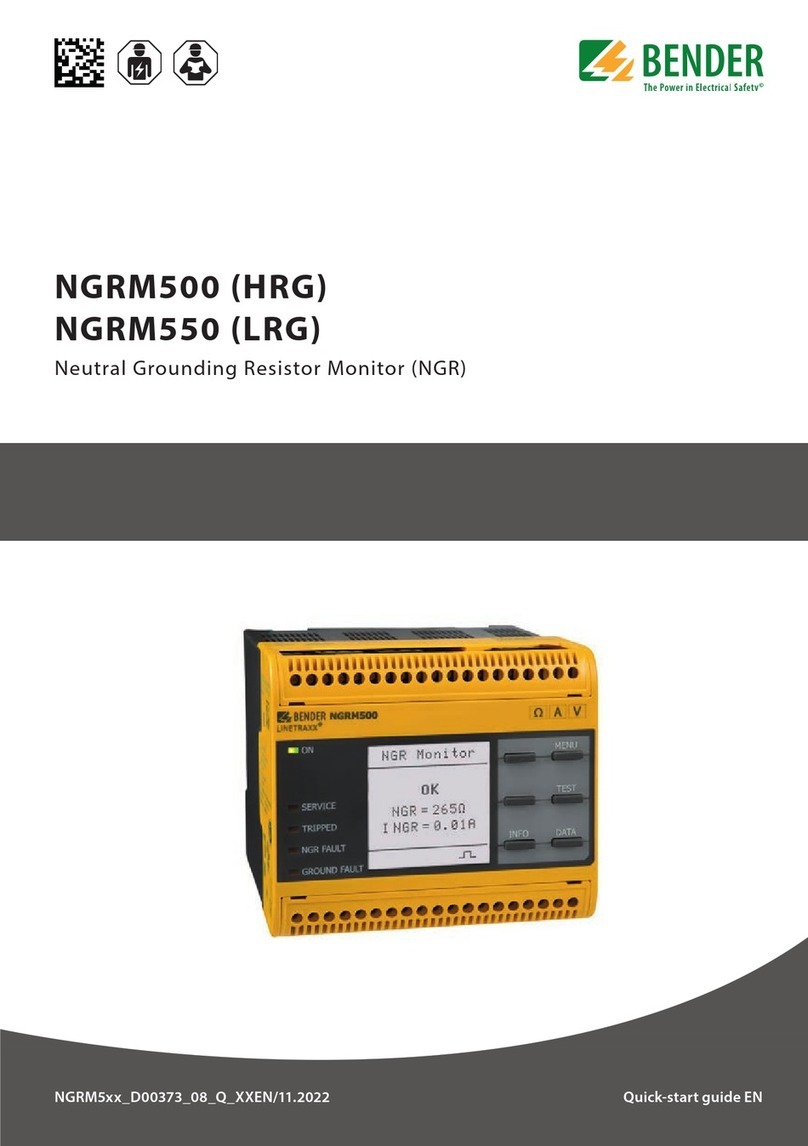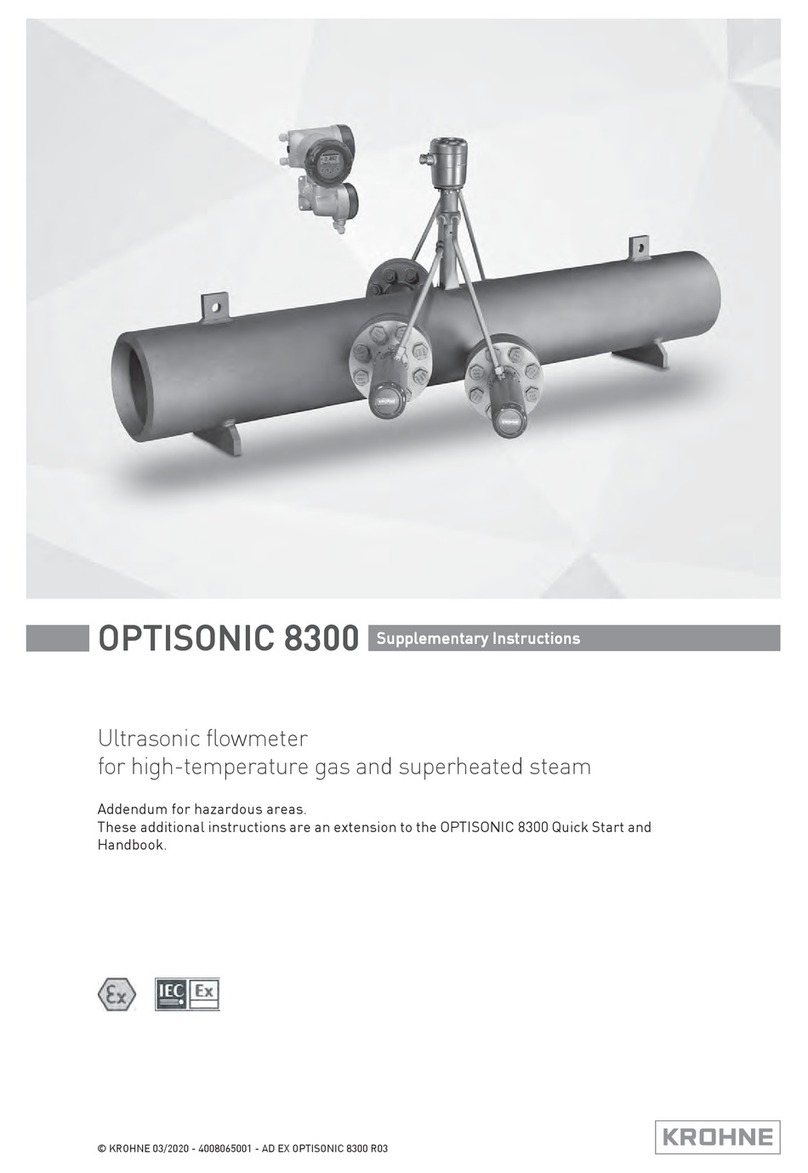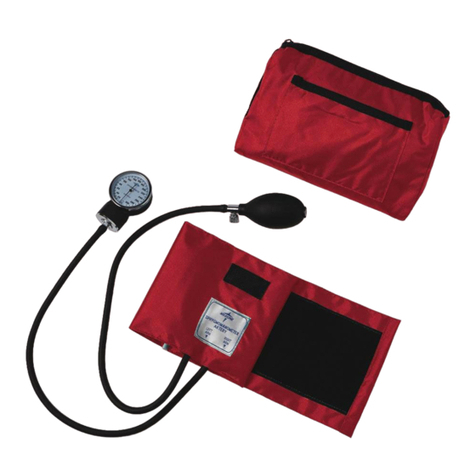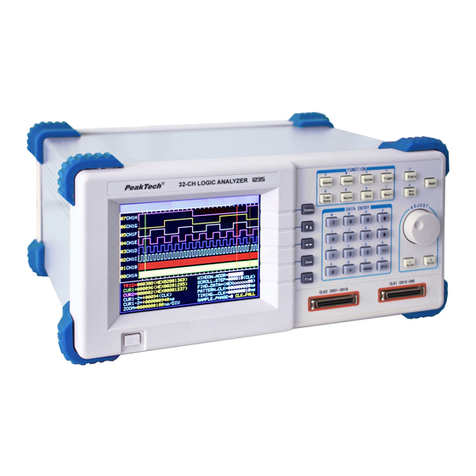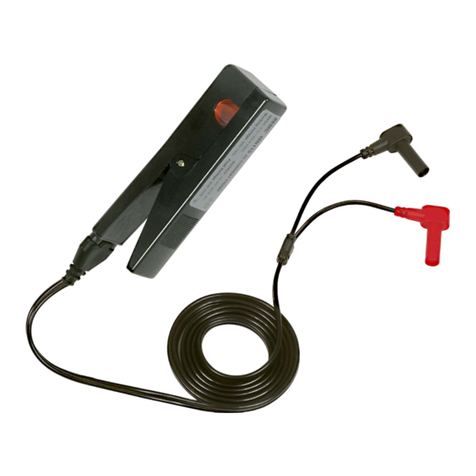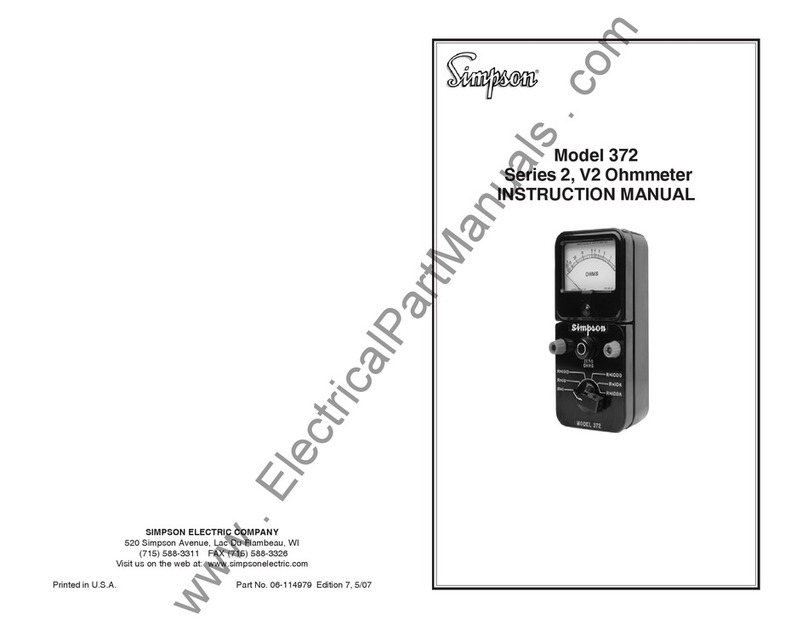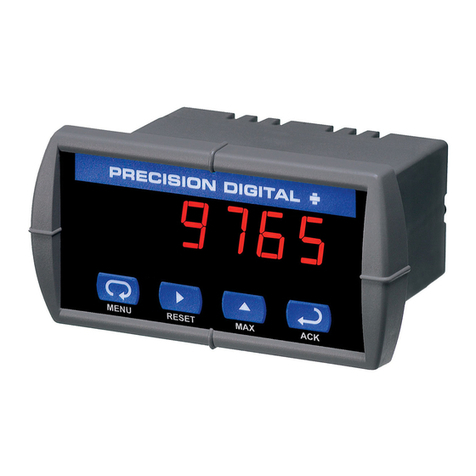EET PMC-D726M User manual

PMC-D726M
Digital Multifunction Meter
User Manual
Version: V1.0
November 7, 2017

CET Electric Technology
2
This manual may not be reproduced in whole or in part by any means without the express
written permission from CET.
The information contained in this manual is believed to be accurate at the time of publication;
however, CET assumes no responsibility for any errors which may appear here and reserves
the right to make changes without notice. Please consult CET or your local representative for
the latest product specifications.
DANGER
This symbol indicates the presence of danger that may result in severe injury or death and
permanent equipment damage if proper precautions are not taken during the installation,
operation or maintenance of the device.
CAUTION
This symbol indicates the potential of personal injury or equipment damage if proper
precautions are not taken during the installation, operation or maintenance of the device.

CET Electric Technology
3
DANGER
Failure to observe the following instructions may result in severe injury or
death and/or equipment damage.
Installation, operation and maintenance of the meter should only be
performed by qualified, competent personnel that have the appropriate
training and experience with high voltage and current devices. The meter must
be installed in accordance with all local and national electrical codes.
Ensure that all incoming AC power and other power sources are turned OFF
before performing any work on the meter.
Before connecting the meter to the power source, check the label on top of
the meter to ensure that it is equipped with the appropriate power supply, and
the correct voltage and current input specifications for your application.
During normal operation of the meter, hazardous voltages are present on its
terminal strips and throughout the connected potential transformers (PT) and
current transformers (CT). PT and CT secondary circuits are capable of
generating lethal voltages and currents with their primary circuits energized.
Follow standard safety precautions while performing any installation or service
work (i.e. removing PT fuses, shorting CT secondaries, …etc).
Do not use the meter for primary protection functions where failure of the
device can cause fire, injury or death. The meter should only be used for
shadow protection if needed.
Under no circumstances should the meter be connected to a power source if it
is damaged.
To prevent potential fire or shock hazard, do not expose the meter to rain or
moisture.
Setup procedures must be performed only by qualified personnel familiar with
the instrument and its associated electrical equipment.
DO NOT open the instrument under any circumstances.

CET Electric Technology
4
Limited warranty
CET offers the customer a minimum of 12-month functional warranty on the
meter for faulty parts or workmanship from the date of dispatch from the
distributor. This warranty is on a return to factory for repair basis.
CET does not accept liability for any damage caused by meter malfunctions. CET
accepts no responsibility for the suitability of the meter to the application for
which it was purchased.
Failure to install, set up or operate the meter according to the instructions herein
will void the warranty.
Only CET’s duly authorized representative may open your meter. The unit should
only be opened in a fully anti-static environment. Failure to do so may damage
the electronic components and will void the warranty.

CET Electric Technology
5
Table of Contents
Chapter 1 Introduction .........................................................................................................................7
1.1 Overview ...............................................................................................................................7
1.2 Features.................................................................................................................................7
1.3 PMC-D726M’s Application in Power and Energy Management Systems.............................8
1.4 Getting more information.....................................................................................................9
Chapter 2 Installation .........................................................................................................................10
2.1 Appearance .........................................................................................................................10
2.2 Dimensions..........................................................................................................................11
2.2.1 Main Unit .................................................................................................................11
2.2.2 Terminals..................................................................................................................12
2.2.3 SCCTs ........................................................................................................................12
2.3 Mounting.............................................................................................................................14
2.4 Wiring connections .............................................................................................................15
2.4.1 3-Phase 4-Wire (3P4W) Wye Direct Connection with 3CTs ....................................15
2.4.2 3-Phase 4-Wire (3P4W) Wye Direct Connection with 2CTs ....................................16
2.4.3 3-Phase 3-Wire (3P3W) Open Delta with 2PTs and 3CTs ........................................16
2.4.4 3-Phase 3-Wire (3P3W) Open Delta with 2PTs and 2CTs ........................................17
2.5 Communications Wiring .....................................................................................................17
2.6 Digital Input Wiring.............................................................................................................18
2.7 Digital Output Wiring..........................................................................................................18
2.8 Analog Output Wiring.........................................................................................................18
2.9 Pulse Output Wiring............................................................................................................18
2.10 Power Supply Wiring.........................................................................................................19
Chapter 3 Front Panel.........................................................................................................................20
3.1 Display.................................................................................................................................20
3.1.1 LCD/LED Testing .......................................................................................................20
3.1.2 LCD Display Areas.....................................................................................................21
3.1.3 LED Display Symbols ................................................................................................22
3.2 Using the Front Panel Buttons............................................................................................22
3.4 Display Screen Types...........................................................................................................23
3.4.1 LCD Data Screens .....................................................................................................23
3.4.2 LED Data Screens .....................................................................................................23
3.5 Setup Configuration via the Front Panel.............................................................................24
3.5.1 Making Setup Changes ............................................................................................24
3.5.2 Setup Menu..............................................................................................................25
3.5.3 Configuration ...........................................................................................................26
Chapter 4 Applications........................................................................................................................29
4.1 Inputs and Outputs .............................................................................................................29
4.1.1 Digital Inputs............................................................................................................29
4.1.2 Digital Output...........................................................................................................29
4.1.3 Energy Pulse Outputs...............................................................................................29
4.1.4 AO Output................................................................................................................30

CET Electric Technology
6
4.2 Power and Energy ...............................................................................................................30
4.2.1 Basic Measurements................................................................................................30
4.2.2 Energy Measurements.............................................................................................30
4.2.3 Demand Measurements ..........................................................................................31
4.3 Power Quality......................................................................................................................31
4.3.1 Phase Angles ............................................................................................................31
4.3.2 Power Quality Parameters.......................................................................................32
4.3.3 Unbalance ................................................................................................................33
4.4 Setpoints .............................................................................................................................33
4.5 Logging ................................................................................................................................35
4.5.1 Peak Demand Log ....................................................................................................35
4.5.2 SOE ...........................................................................................................................35
4.6 Time of Use (TOU)...............................................................................................................36
Chapter 5 Modbus Register Map ........................................................................................................37
5.1 Basic Measurements...........................................................................................................37
5.2 Energy Measurements........................................................................................................38
5.3 Harmonic Measurements ...................................................................................................39
5.3.1 Power Quality Measurements.................................................................................39
5.3.2 Current Harmonic Measurements...........................................................................39
5.3.3 Voltage Harmonic Measurements...........................................................................39
5.4 Demands .............................................................................................................................40
5.4.1 Present Demands.....................................................................................................40
5.4.2 Peak Demand Log of This Month (Since Last Reset) ...............................................40
5.4.3 Peak Demand Log of Last Month (Before Last Reset) .............................................40
5.4.4 Demand Data Structure...........................................................................................40
5.5 SOE Log................................................................................................................................40
5.6 Device Setup........................................................................................................................42
5.6.1 Basic Setup Parameters ...........................................................................................42
5.6.2 I/O Setup Parameters...............................................................................................44
5.6.3 Setpoints Setup........................................................................................................44
5.7 TOU Setup ...........................................................................................................................45
5.7.1 Basic .........................................................................................................................45
5.7.2 Season......................................................................................................................46
5.7.3 Daily Profile..............................................................................................................46
5.7.4 Alternate Days..........................................................................................................47
5.8 Time.....................................................................................................................................47
5.9 DO Control...........................................................................................................................48
5.10 Meter Information ............................................................................................................48
Appendix A Technical Specifications....................................................................................................50
Appendix B Standards Compliance .....................................................................................................52
Appendix C Ordering Guide ................................................................................................................53
Contact us ..........................................................................................................................................54

CET Electric Technology
7
Chapter 1 Introduction
This manual explains how to use the PMC-D726M Digital Multifunction Meter. Throughout the manual
the term “meter” generally refers to all models. Differences between the models are indicated with the
appropriate model number.
This chapter provides an overview of the PMC-D726M meter and summarizes many of its key features.
1.1 Overview
The PMC-D726M Digital Multifunction Meter is CET’s latest offer for the low-cost digital power/energy
metering market. Housed in an industry standard DIN form factor measuring 72mmx72mmx71.8mm
(LCD) or 72mmx72mmx76.8mm (LED), it is perfectly suited for industrial, commercial and utility
metering applications. The PMC-D726M features quality construction, true RMS multifunction
measurements and a LED or LCD display. Compliance with the IEC 62053-21 Class 1 kWh Accuracy
Standard, it provides optimum Price to Value ratio and is a cost effective replacement for traditional
analog instrumentation, capable of displaying 3-phase measurements at once. The PMC-D726M
optionally provides Split-Core CT (SCCT) support for retrofit situations, two Digital Inputs for status
monitoring, two Digital Output for control, or one 0/4-20mA Analog Output for interfacing with 3rd
party SCADA system. The standard SOE Log records meter events such as power-off, setup changes, DI
status changes in 1ms resolution. With the optional RS485 port and Modbus protocol support, the PMC-
D726M becomes a vital component of an intelligent, multifunction monitoring solution for any Power
and Energy Management systems.
You can setup the meter through its front panel or via our free PMC Setup software. The meter is also
supported by our PecStar® iEMS Integrated Energy Management System.
Following is a list of typical applications for the PMC-D726M:
Analog meter replacement
Industrial, Commercial and Utility panel metering
Substation, Factory and Building Automation
Sub-metering and Cost Allocation
Ideal for retrofitting with SCCT option
Contact CET Technical Support should you require further assistance with your application.
1.2 Features
Ease of use
Large, bright, backlit LCD or high-contrast LED display
Front panel kWh and kvarh LED energy pulse outputs
Password-protected setup via front panel or free PMC Setup software
Easy installation with mounting clips, no tools required
Measurements
Uln, Ull per phase and Average
Current per phase and Average with calculated Neutral
kW, kvar, kVA, P.F. per phase and Total
Bi-directional energy measurements
Frequency

CET Electric Technology
8
PQ Measurements*
THD, TOHD, TEHD and Individual Harmonics up to 31st
TDD, K-Factor and Crest-Factor
U and I Unbalance and Phase Angles
*Available in Firmware V1.00.04 (LED)/V1.01.04 (LCD) or later
Setpoints*
6 user programmable Setpoints with extensive list of monitoring parameters including Voltage,
Current, Power and Demand
Configurable Threshold and Time Delay
SOE Logging and DO trigger
*Available in Firmware V1.00.04 (LED)/V1.01.04 (LCD) or later
SOE Log
16 events time-stamped to ±1ms resolution
Record all setup, Setpoint and Digital Input status changes
TOU and Demand*
One TOU schedule, providing
o6 Seasons
o6 Daily Profiles, each with 6 Periods in 15-minute interval
o10 Holidays or Alternate Days
o4 Tariffs, each providing kWh and kvarh Imp/Exp and kVAh
Demands and Peak Demands with Timestamp for per phase Current, kW Total, kvar Total and kVA
total
*Available in Firmware V1.00.04 (LED)/V1.01.04 (LCD) or later
Optional Inputs and Outputs
Two Digital Inputs for Status Monitoring
Two Digital Outputs for Control applications*
One Analog Output at 0/4-20mA
Two Solid State Relay Output for Energy Pulsing applications*
*The options of 2DIs + 2DOs and 2DIs + 2SSR Pulse Outputs are available in Firmware V1.00.03
(LED)/V1.01.03 (LCD) or later
Optional Communications
Optically isolated RS-485 port at 1200 to 19,200 bps
Modbus RTU support
System Integration
Supported by CET’s PecStar® iEMS and PMC Setup
Easy integration into other Automation, SCADA or BMS systems via Modbus RTU
1.3 PMC-D726M’s Application in Power and Energy Management Systems
The PMC-D726M can be used to monitor Wye or Delta connected power system. Modbus
communications allow real-time data, events, DI status and other information to be transmitted across
a RS485 network to an Integrated Energy Management system such as the PecStar® iEMS.

CET Electric Technology
9
Figure 1-1 PMC-D726M’s application
1.4 Getting more information
Additional information is available from CET via the following sources:
Visit www.cet-global.com
Contact your local representative
Contact CET directly via email or telephone

CET Electric Technology
10
Chapter 2 Installation
2.1 Appearance
Figure 2-1 Appearance (LCD)
Figure 2-2 Appearance (LED)
Caution
Installation of the PMC-D726M should only be performed by qualified, competent
personnel that have the appropriate training and experience with high voltage and current
devices. The meter must be installed in accordance with all local and national electrical
codes.
During the operation of the meter, hazardous voltages are present at the input terminals.
Failure to observe precautions can result in serious or even fatal injury and equipment
damage.

CET Electric Technology
11
Figure 2-3 Rear Panel (2DI)
2.2 Dimensions
2.2.1 Main Unit
Figure 2-4 Dimension (LCD)
Figure 2-5 Dimensions (LED)

CET Electric Technology
12
2.2.2 Terminals
Figure 2-6 Terminal Dimensions
Terminal
Terminal Dimensions
Wire Size
Max. Torque
1
DI
2.6mm x 3.3mm
1.5mm2
5 kgf.cm/M3
(4.3 lb-in)
RS485
Power Supply
2
Current Input/Voltage Input
6.4mm x 6.4mm
1.0mm2- 2.5mm2
(14AWG - 22AWG)
6.0 kgf.cm/M3
(5.2 lb-in)
Table 2-1 Terminal Dimensions
2.2.3 SCCTs
PMC-SCCT-5A-2.5mA-A
Figure 2-7 PMC-SCCT-5A-2.5mA-A Dimensions

CET Electric Technology
13
PMC-SCCT-100A-40mA-16-A
Figure 2-8 PMC-SCCT-100A-40mA-16-A Dimensions
PMC-SCCT-200A-40mA-24-A
Figure 2-9 PMC-SCCT-200A-40mA-24-A Dimensions
PMC-SCCT-400A-40mA-35-A
Figure 2-10 PMC-SCCT-400A-40mA-35-A Dimensions

CET Electric Technology
14
PMC-SCCT-800A-40mA-A
Figure 2-11 PMC-SCCT-800A-40mA-A Dimensions
2.3 Mounting
The PMC-D726M should be installed in a dry environment with no dust and kept away from heat,
radiation and electrical noise source.
Installation steps:
Remove the installation clips from the meter
Fit the meter through a 68mmx68mm cutout as shown in Figure 2-12 (LCD) or Figure 2-13 (LED)
Re-install the installation clips and push the clips tightly against the panel to secure the meter
Figure 2-12 Panel Cutout (LCD)

CET Electric Technology
15
Figure 2-13 Panel Cutout (LED)
2.4 Wiring connections
PMC-D726M can satisfy both Wye and Delta three phase power systems. Please read this section
carefully before installation and choose the correct wiring method for your power system. The following
Wiring Modes are supported:
3-Phase 4-Wire (3P4W) Wye Direct Connection with 3CTs
3-Phase 4-Wire (3P4W) Wye Direct Connection with 2CTs
3-Phase 3-Wire (3P3W) open Delta with 2PTs and 3CTs.
3-Phase 3-Wire (3P3W) open Delta with 2PTs and 2CTs
2.4.1 3-Phase 4-Wire (3P4W) Wye Direct Connection with 3CTs
Please consult the serial number label to ensure that the system phase voltage is less than or equal to
the meter’s voltage input specification.
Set the Wiring Mode to Wye.
Caution
Under no circumstances should the PT secondary be shorted.
Under no circumstances should the CT secondary be open when the CT primary is
energized. CT shorting blocks should be installed to allow for easy maintenance.

CET Electric Technology
16
Figure 2-14 3-Phase 4-Wire Wye, no PTs, 3 CTs
2.4.2 3-Phase 4-Wire (3P4W) Wye Direct Connection with 2CTs
Please consult the serial number label to ensure that the system phase voltage is less than or equal to
the meter’s voltage input specification.
Set the Wiring Mode to Wye.
Figure 2-15 4-Wire Wye, no PTs, 2 CTs
2.4.3 3-Phase 3-Wire (3P3W) Open Delta with 2PTs and 3CTs
Please consult the serial number label to ensure that the rated PT secondary voltage is less than or
equal to the meter’s rated phase voltage input specification.
Set the Wiring Mode to Delta.

CET Electric Technology
17
Figure 2-16 3-Phase 3-Wire Delta, 2PTs, 3CTs
2.4.4 3-Phase 3-Wire (3P3W) Open Delta with 2PTs and 2CTs
Please consult the serial number label to ensure that the rated PT secondary voltage is less than or
equal to the meter’s rated phase voltage input specification.
Set the Wiring Mode to Delta.
Figure 2-17 3-Phase 3-Wire Delta, 2PTs, 2CTs
2.5 Communications Wiring
The PMC-D726M provides one RS485 port and supports the Modbus RTU protocol. Up to 32 devices
can be connected on a RS485 bus. The overall length of the RS485 cable connecting all devices should
not exceed 1200m.
If the master station does not have a RS485 communications port, a RS232/RS485 or USB/RS485

CET Electric Technology
18
converter with optically isolated output and surge protection should be used. The following figure
illustrates the RS-485 connections on the PMC-D726M.
Figure 2-18 Communications Connections
2.6 Digital Input Wiring
The following figure illustrates the Digital Input connections on the PMC-D726M:
Figure 2-19 DI Connections
2.7 Digital Output Wiring
The following figure illustrates the Digital Output connections on the PMC-D726M:
Figure 2-20 DO Connections
2.8 Analog Output Wiring
The following figure illustrates the Analog Output connections on the PMC-D726M:
Figure 2-21 AO Connections
2.9 Pulse Output Wiring
The following figure illustrates the Pulse Output connections on the PMC-D726M:

CET Electric Technology
19
Figure 2-22 Pulse Output Connections
2.10 Power Supply Wiring
For AC supply, connect the live wire to the L/+ terminal and the neutral wire to the N/- terminal.
For DC supply, connect the positive wire to the L/+ terminal and the negative wire to the N/- terminal.
Figure 2-23 Power Supply Connections

CET Electric Technology
20
Chapter 3 Front Panel
The PMC-D726M meter has a large, bright, backlit LCD or a high-contrast LED display and four buttons
for data display and meter configuration. This chapter introduces the front panel operations.
Figure 3-1 Front Panel (LCD)
Figure 3-2 Front Panel (LED)
3.1 Display
3.1.1 LCD/LED Testing
Pressing both the <Phase> and the <Energy> buttons simultaneously for 2 seconds enters the LCD/LED
Testing mode. All LCD/LED segments and LED indicators are illuminated during testing. The LCD/LED will
return to its normal display mode when any button is pressed.
Figure 3-2 Full LED/LCD Display
Table of contents
Other EET Measuring Instrument manuals
